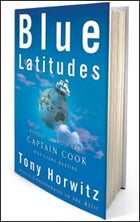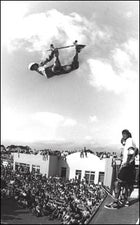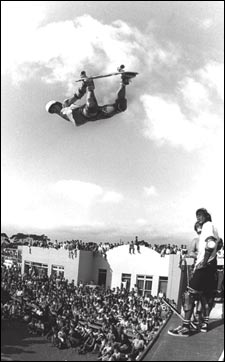BLUE LATITUDES
From Our Pages
���ϳԹ��� adventure laureate Tim Cahill journeys from Sahara salt mines to a Jamaica yoga retreat in his new collection, Hold the Enlightenment: More Travel, Less Bliss (Villard, ).
 Pairing lively history with nearly 30 years of vintage photos, Jocko Weyland’s The Answer Is Never (Grove Press, ) proves that skateboarding has always been undeniably cool, from its first appearance in 1964 as “sidewalk surfing” to its current mass appeal as an X-Games headliner.
Pairing lively history with nearly 30 years of vintage photos, Jocko Weyland’s The Answer Is Never (Grove Press, ) proves that skateboarding has always been undeniably cool, from its first appearance in 1964 as “sidewalk surfing” to its current mass appeal as an X-Games headliner. Boldly Going Where Captain Cook Has Gone Before
BY TONY HORWITZ
(Henry Holt, $26)
TONY HORWITZ HAS written about oddball history buffs before, in his Civil War romp Confederates in the Attic. This time he becomes one himself, retracing the three major voyages of Captain James Cook, the British navigator who charted the Pacific from Botany Bay to Bora Bora from 1769 to 1779 and returned with news of a sensuous tropical paradise. The author sets off island-hopping across the South Pacific in the wake of Cook’s Endeavour, producing some classically absurd Horwitzian scenes, including a bold foray into a hostile Maori bar and a celebration of Cook’s landing in Cooktown, Australia, that devolves into a “shocking piss-up.” But there are sobering moments, too; Horwitz finds many islands in the grip of a fierce anticolonialism, with Cook as convenient lightning rod. “[A] lot of people just see him as the first bad guy,” explains one Hawaiian park ranger, “a symbol of everything bad that followed.” Horwitz offers an affectionate but convincing defense of the captain as a man driven by a “stubborn Enlightenment faith in firsthand observation,” and conjures the “strangeness and wonder” of his hero’s primal encounters by getting off the beaten path himself. “Traveling virtually blind to a land I hadn’t known existed, and whose name I couldn’t even pronounce,” Horwitz writes, “seemed as close as I could get to the freshness of discovery I so envied in Cook’s voyages.”
—ROB BUCHANAN
SEEING IN THE DARK
How Backyard Stargazers Are Probing Deep Space and Guarding Earth from Interplanetary Peril
BY TIMOTHY FERRIS
(Simon & Schuster, $26)
NOT SATISFIED with having produced two classics of science writing—’Coming of Age in the Milky Way and The Whole Shebang—Berkeley professor emeritus Timothy Ferris has gone and written a third. Seeing in the Dark combines elegant memoir with McPhee-style reportage about the revolution in astronomy that has made it the most amateur-friendly field in science. Growing up in Key Biscayne, Florida, in the 1950s, Ferris was awed by rockets blasting off from nearby Cape Canaveral and by his first look through a cheap mail-order spyglass. “What lay before me was nothing less than the whole universe,” he writes. “But to see more of it, I’d need a better telescope.” By the late 1980s, technology had produced that grail, giving amateurs Palomar Mountain-quality equipment. And with the Internet, writes Ferris, they could communicate new finds instantly: “It was as if the planet had suddenly grown thousands of new eyes.” Scanning the skies for the killer asteroid that will do us in like the dinosaurs, Ferris and his fellow stargazers take away far more than mere data: “If you have seen plasma arches rising off the edge of the Sun, yellow dust storms raging on Mars, angry red Io emerging from the shadow of Jupiter, the golden rings of Saturn,” he writes, “if, in short, you have seen not only this world but something of the other worlds, too—well then, you have lived.”
—BRUCE BARCOTT
SEA ROOM
An Island Life in the Hebrides
BY ADAM NICOLSON
(North Point Press, $27)
Twenty years ago, on his 21st birthday, British author Adam Nicolson received a remarkable present from his father: three small, cliff-strewn islands in the Minch Channel, the storm-tossed body of water separating Scotland from the wild Outer Hebrides. In the early spring of 1999, Nicolson settles into the islands’ lone, rat-infested house and, as the season advances, describes virtually every aspect of his beloved Hebrides. Nicolson is a pure stylist, capable of breathing life into almost anything. “Pull away the kelp and the serrated wrack,” he writes of one key to the islands’ geology, a seam where ancient magma and mudstone meet. “The little green crabs scuttle for the dark, the tiny transparent shrimps wriggle like rugby players in a tackle, and you can see the instant of creation frozen and preserved in front of you.” He’s also an example of something nearly extinct in this Age of Ownership: the benign landlord. “Land—particularly land that is out on the edge of things, and particularly land that is a rich concentration of the marvels of the natural world—is to be shared,” Nicolson writes. With Sea Room, he has done just that.
—R.B.
DR. TATIANA’S SEX ADVICE TO ALL CREATION
The Definitive Guide to the Evolutionary Biology of Sex
BY OLIVIA JUDSON
(Metropolitan Books, $24)
If there’s one thing we know about sex in the natural world, it’s that males are philanderers and females are chaste, right? Not so! says Dr. Tatiana, aka Olivia Judson, an Oxford-trained evolutionary biologist whose debut book, written as a sex-advice column for critters, investigates the mating conundrums that bedevil the animal and insect world. “In most species,” she writes, “girls are more strumpet than saint. Rather than just mating once, they’ll mate with several fellows, and often with far, far more than necessary just to fertilize their eggs.” Having debunked that canard, Dr. T tackles stickier wickets such as gay sex among manatees and that age-old dilemma: cannibalism—best before sex or after? The Dr. Tatiana approach—which evolved from an article in The Economist—may be too cute for readers who prefer their science in lab coats and Latin. But for the rest of us, Judson’s witty, well-researched vignettes are a guilty pleasure, natural history that goes down as sweet as a trashy tell-all.
—B.B.

